Brief

Executive Summary
- The tied-agency insurance channel is shifting from a “push” model focused on acquiring customers to a “pull” model that addresses customers’ needs and priorities at the right moments.
- For this model to flourish, insurers need to develop a powerful lead engine to feed their tied agents.
- That lead engine will be powered by mastery of advanced analytics, identification of trigger points in customers’ lives, digital marketing, and, increasingly, embedding insurance into digital platforms and ecosystems.
- Done right, the new model makes the agent job profile more attractive to young people who enjoy working with customers but also thrive on digital tools and want hybrid home/office flexibility.
With the rise of direct sales in insurance distribution about a decade ago, the tied-agency channel was deemed obsolete by many in the industry. Yet it never disappeared. In fact, tied agency remains an attractive and profitable channel for many insurers, even when measured against purely digital models.
Effective ways of working, however, have changed radically. Today’s customers have embraced digital search and shopping for their insurance products but still want to speak with an agent for more complex issues. For example, roughly 40% of US auto insurance customers use digital channels to compare policy options, but they place more value on human interactions for advice and purchasing, according to Bain & Company’s recent NPS Prism® survey of 30,000 respondents. Customers who engage in omnichannel journeys generally give higher Net Promoter Scores—a key metric of advocacy—than those who use only digital channels (see Figure 1).
Many US auto insurance customers use digital self-serve channels but value human interactions for comparing options, advice, and purchase
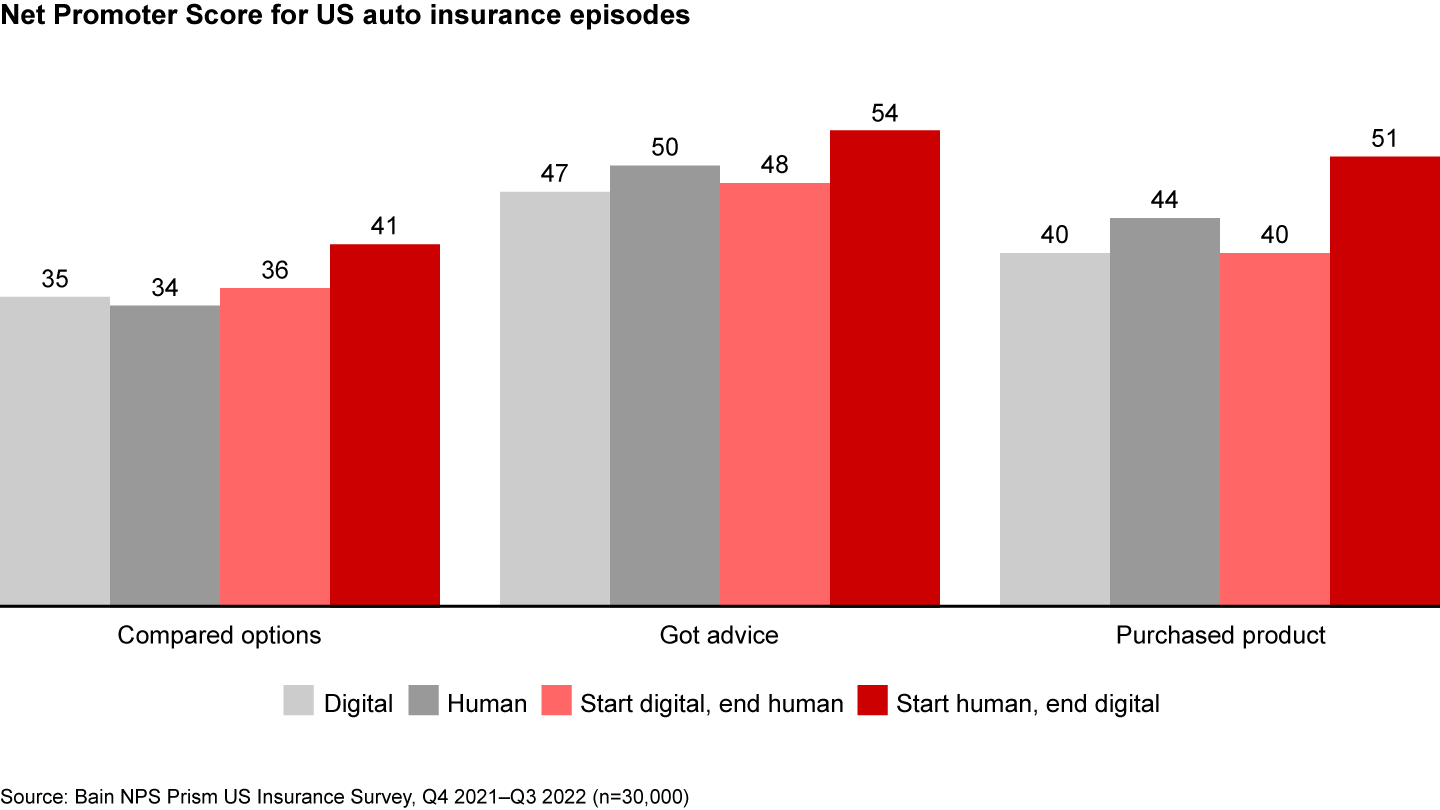
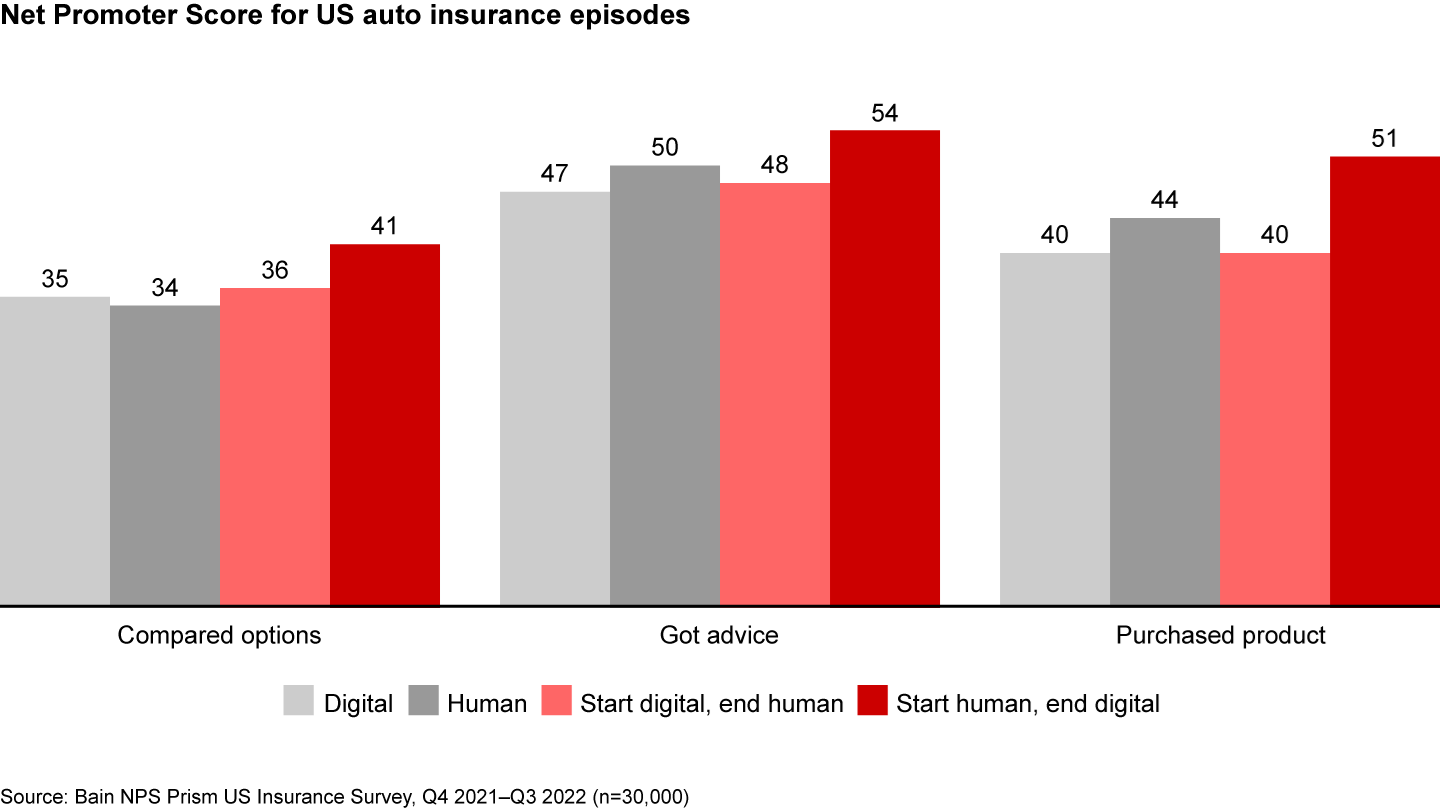
To keep up with changing customer behavior, insurers have started to closely link their channels together. And leading firms are beginning to shift their distribution approach from “push” (focused on acquisition) to “pull” by using real-time data signals and advanced analytics to address customers’ needs and priorities at the right inflection points. This marks a profound change for an industry that has relied for decades on commission-based hunting.
The emerging lead-fed agency model can substantially raise agent productivity and make the job more attractive for young people, but it will require building out new capabilities for both the insurer and the agency.
Deliver an unparalleled experience
Use NPS Prism® as your window into how your customers want to be served.
Learn How
Building a powerful lead engine
Insurers are the ones developing leads and feeding them to tied agents or their own direct-sales call centers. They have access to rich customer data at many touchpoints, and they have more resources to develop lead-generation capabilities. Building a powerful lead engine depends on mastery of several components.
Advanced sales analytics. The broad discipline of sales analytics has become essential for generating high-quality leads across all channels. It requires connected IT systems and a well-maintained customer data platform to enable real-time data signals across various points of contact with customers. Recent Bain benchmarking of 320 financial services firms worldwide found that leaders (defined as having significant market share and revenue growth over a two-year period) are 2.6 times more likely than laggards (maintaining or losing market share and revenues) to have a fully integrated view of the customer, and they are 5.1 times more likely to have end-to-end integration of technology platforms (see Figure 2).
Connecting customer data sets improves real-time data mining
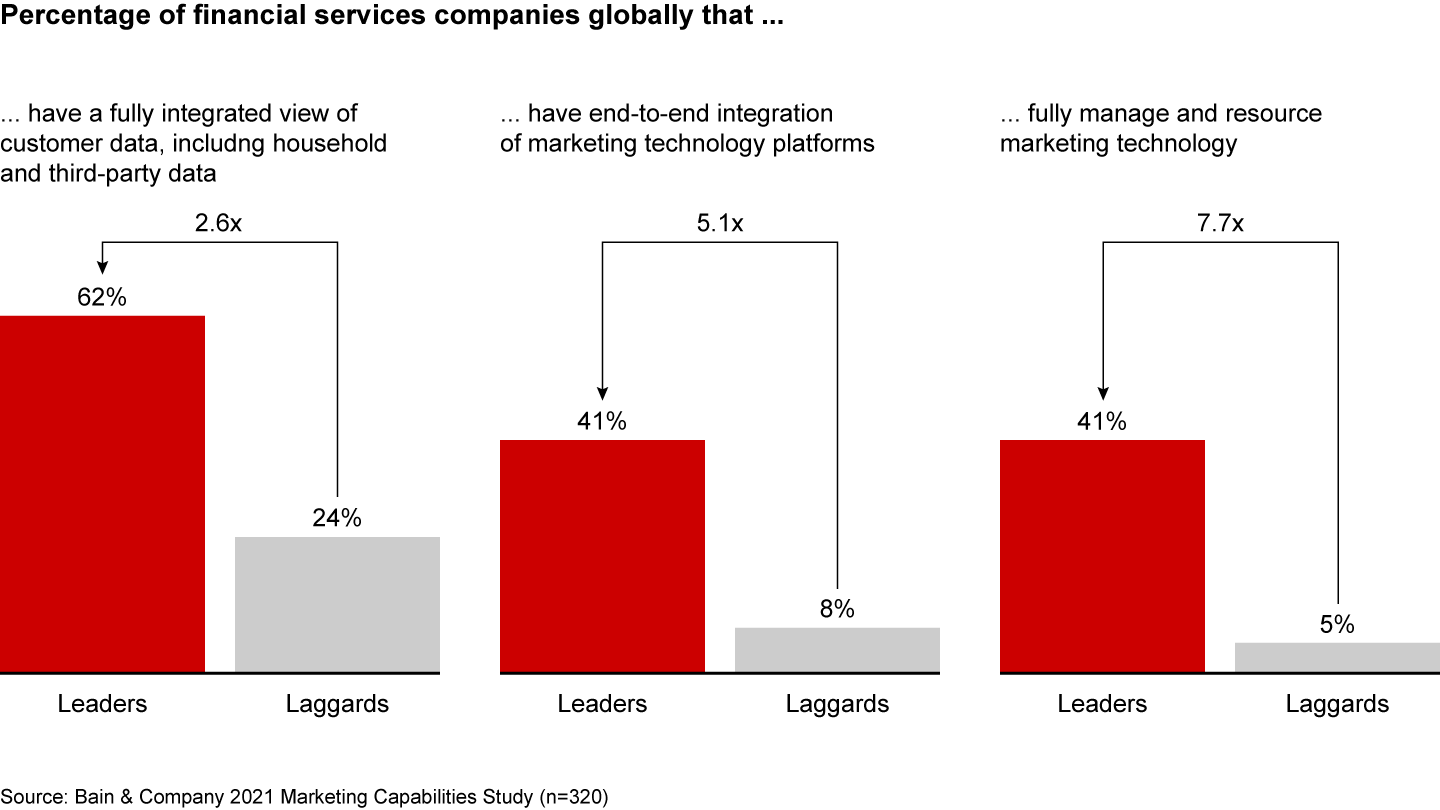
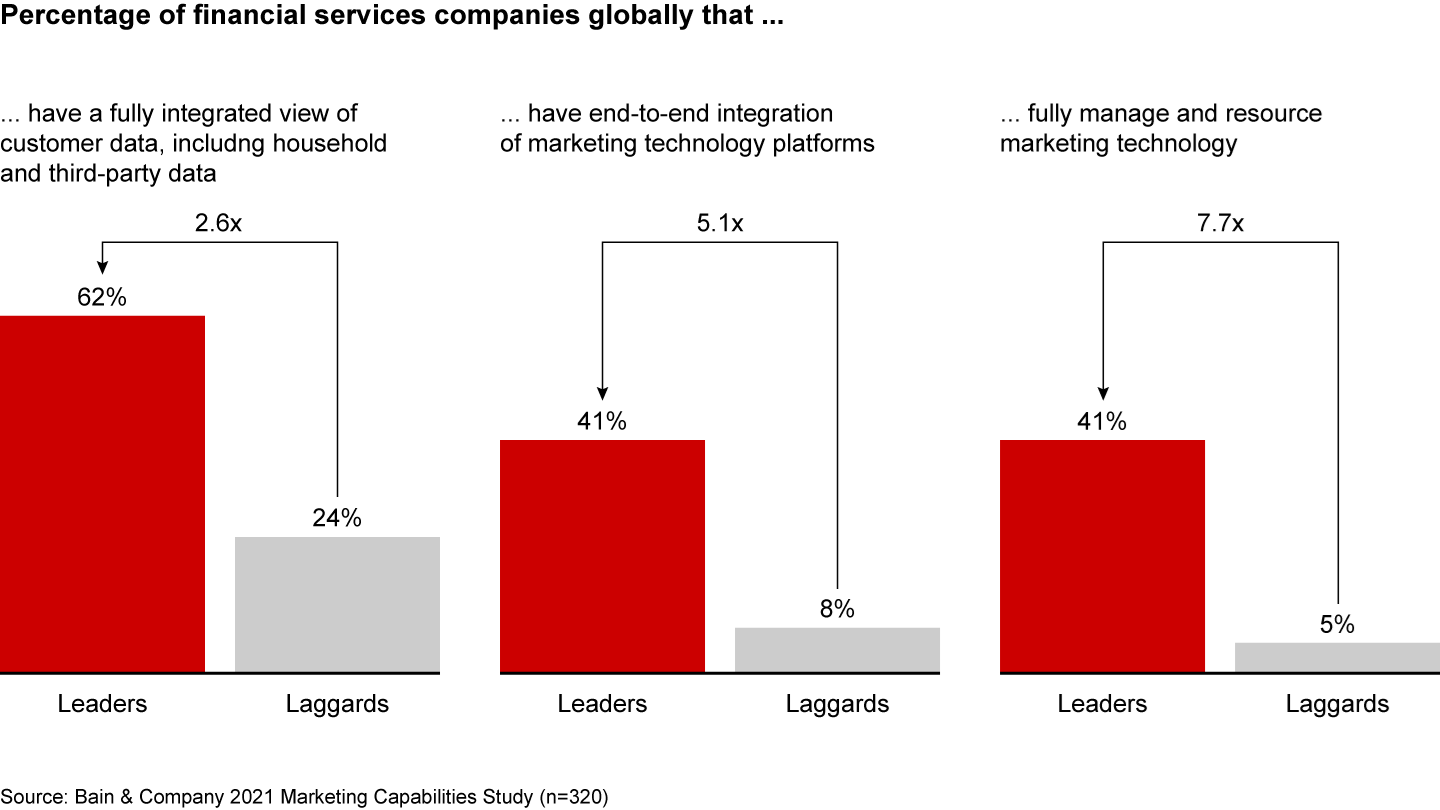
Machine learning now informs cross-selling, for instance, by identifying the next best offer at a particular moment. Consider how one insurance company with a bancassurance partnership built a predictive model by merging past campaign response data with bank transactional data. The model scored bank leads and selected customers for call center targets. As a result, the company realized a significant double-digit increase in lead conversion over the control group, along with a similar rise in revenue.
Trigger-point identification. Lead generation involves identifying data signals that reveal events when a customer can be approached based on a perceived need. The relevant data comes first from internal sources such as customer service data, the agency customer relationship management system, or the claims system. A second step involves expanding the data sets via external sources, such as geographic code data, customer ratings, or social media scraping.
One insurer, for instance, identified claims events with high customer satisfaction and routed those leads automatically to its tied agency, which could approach the customer for cross-selling. This led to double-digit conversion rates in two separate pilots.
Adoption of these methods remains low, given the challenges of unconnected IT systems, poor data quality, and service incentives that favor throughput over longer calls to generate leads. Yet more insurers are making progress, experimenting with use cases such as defining the next best offer or predicting which customers will churn, and they are starting to identify trigger points for those use cases.
Digital marketing savvy. Returning to our benchmarking of financial services firms, the leaders excel in blending personalization of products with a consistent brand experience. They are 1.5 times more likely than laggards to customize their media campaigns and 1.5 times more likely to use predictive analytics for their customization. Here, the way to optimize spending is to undertake testing at a large scale, in order to continuously adapt target audiences, campaigns, channels, and media mix to a changing market environment.
A US property and casualty insurer that needed to invigorate organic growth set about identifying strategies that would quickly improve the return on its digital marketing. The company zeroed in on about 20 experiments to enhance marketing effectiveness by emphasizing customers’ predicted lifetime value, rather than the typical campaign engagement metrics. One initiative was to redirect ad spending on social media platforms, focusing on more attractive customer age and lifestyle segments. Overall, the experiments raised the number of high-quality leads into the agent channel, resulting in higher conversion rates as well as increased customer lifetime premium value. This type of experimentation at scale produces new data that allows insurers to continuously improve their lead engines and boost agents’ ability to convert the sale.
Ecosystems and platforms. The more that customers engage with their insurer, the greater their loyalty and advocacy for the firm. Yet insurers still struggle to establish regular interactions with customers. Ecosystems and digital platforms can help. Platforms with embedded insurance are spreading, and customers increasingly trust them.
Embedding insurance products into digital platforms doesn’t just drive sales in direct channels; it can help generate leads for the insurer’s omnichannel agency salesforce. AIA, for instance, uses the Vitality health services platform to create leads for AIA life and health insurance products. At first glance, such platforms might appear to threaten the agency channel, but they also present opportunities to offer hybrid advice. Insurers are currently working on how to best convert leads generated from purchases in their ecosystems.
Wanted: Digital-native agents
If the new approach is done right, the resources provided by the insurer—analytically driven leads, technology, central services, and more—promise to boost agent productivity. Bain benchmarking in Germany shows that top agents were able to raise their productivity over two recent years twice as much as other agents, partly due to greater adoption of technology (see Figure 3).
Top agents used more digital technologies during the pandemic and were more productive as a result
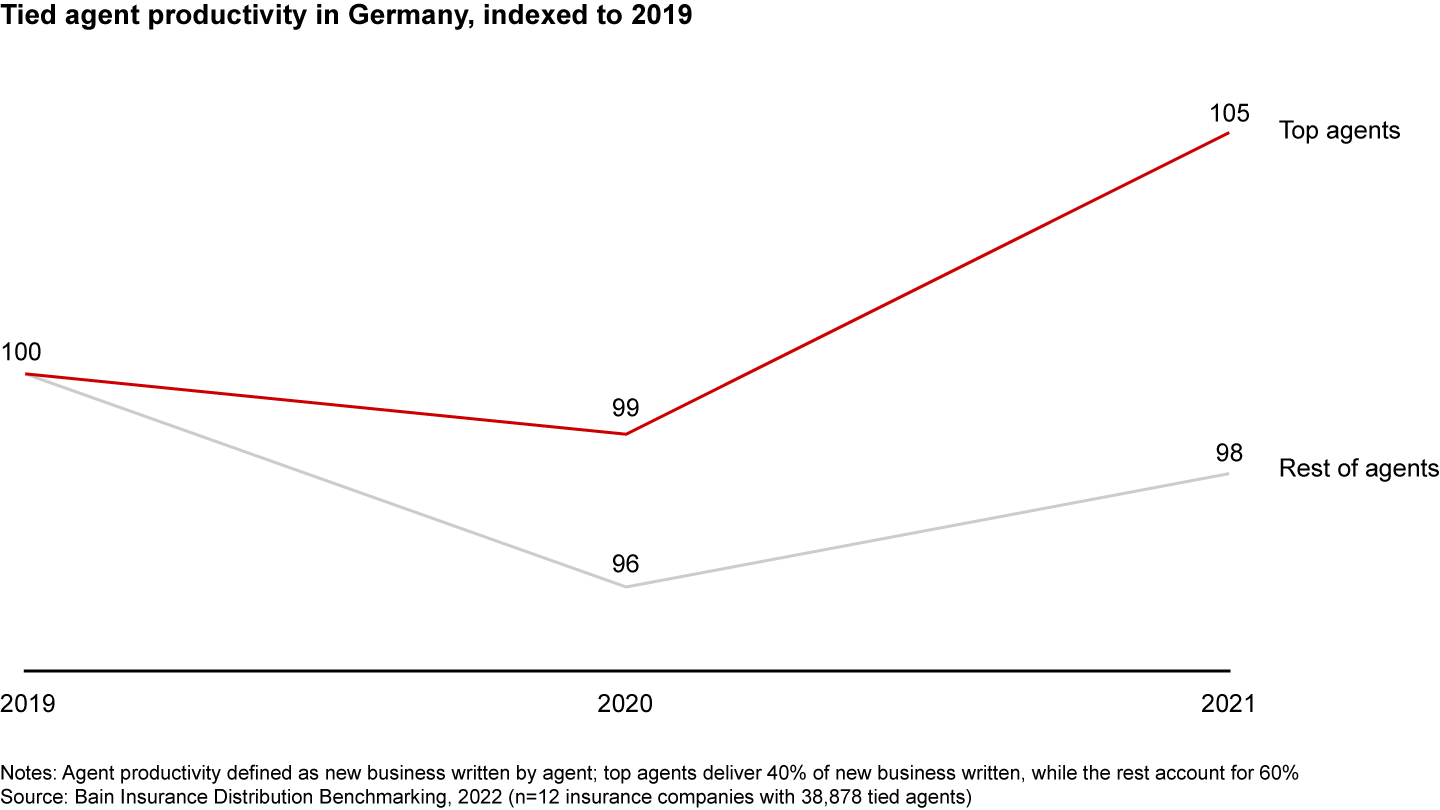
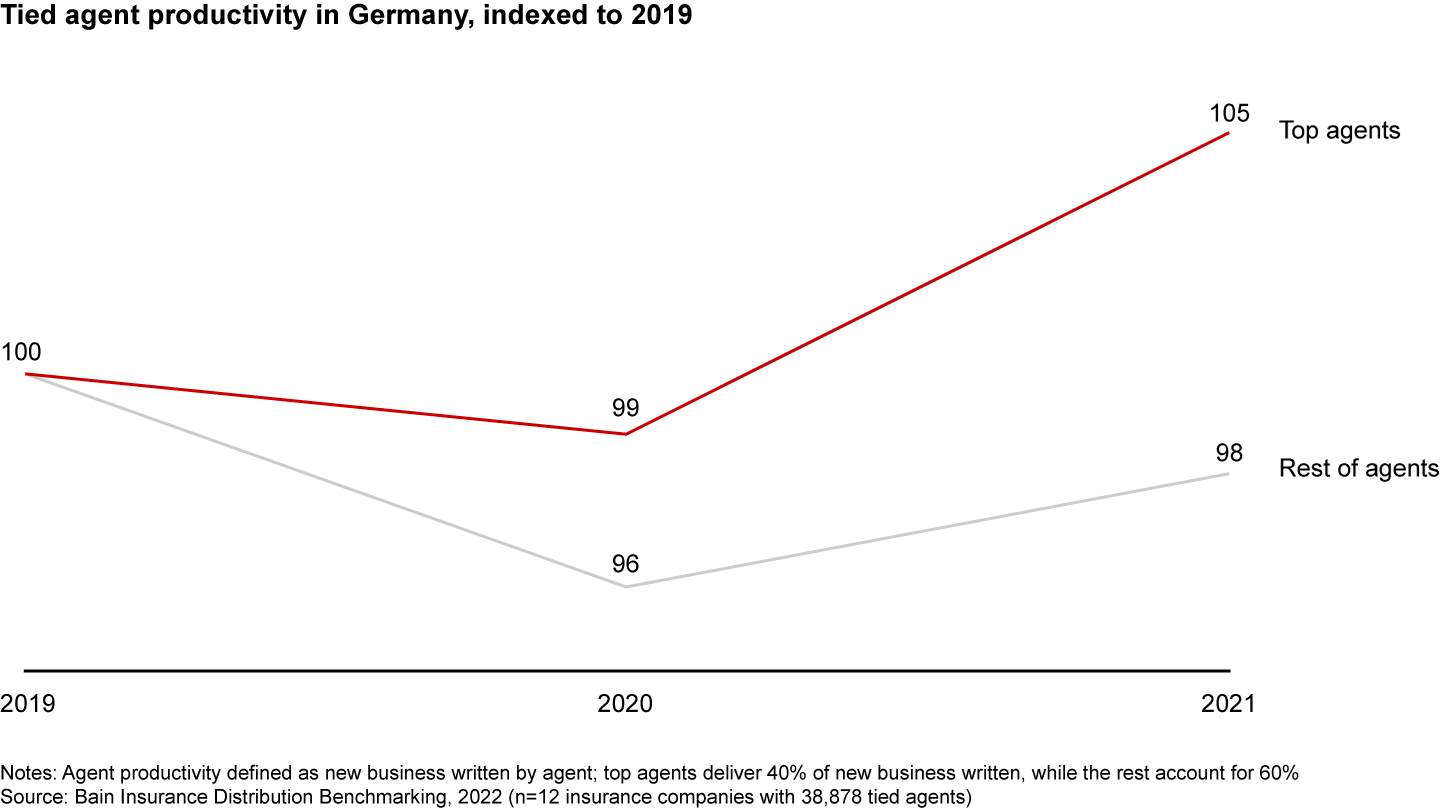
Moving to a digitally enabled, lead-fed agency model also could make the tied-agent job profile more attractive to young employees who enjoy working with customers but seek a digital-intensive environment and hybrid home/office flexibility. As customers interact with insurers through multiple channels, agents will continue to play a critical role in distribution. But ways of working will change dramatically—less time spent on low-value tasks, more time on building relationships that have been primed by an insurer’s data-informed analysis. So, firms that move sooner to the new ways of working will have one more advantage in the battle for talent.
Despite the growing importance of digital tools for customers, the tied-agency channel turns out to be as relevant as ever. But its purpose, and the most effective ways of working, have changed. Insurers that manage to improve their digital capabilities and use them to create a powerful lead engine for agents who work seamlessly in an omnichannel model stand to realize higher sales productivity for years to come.